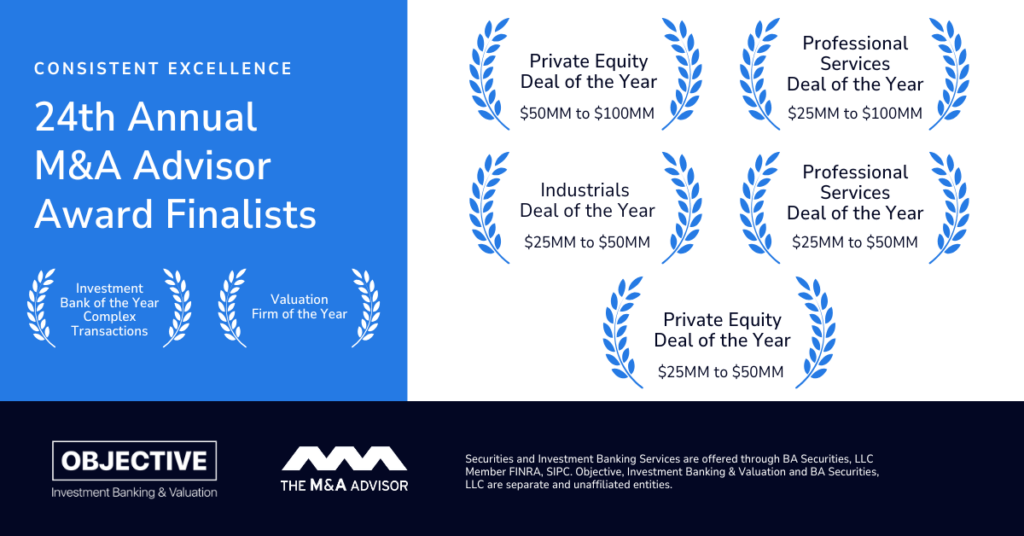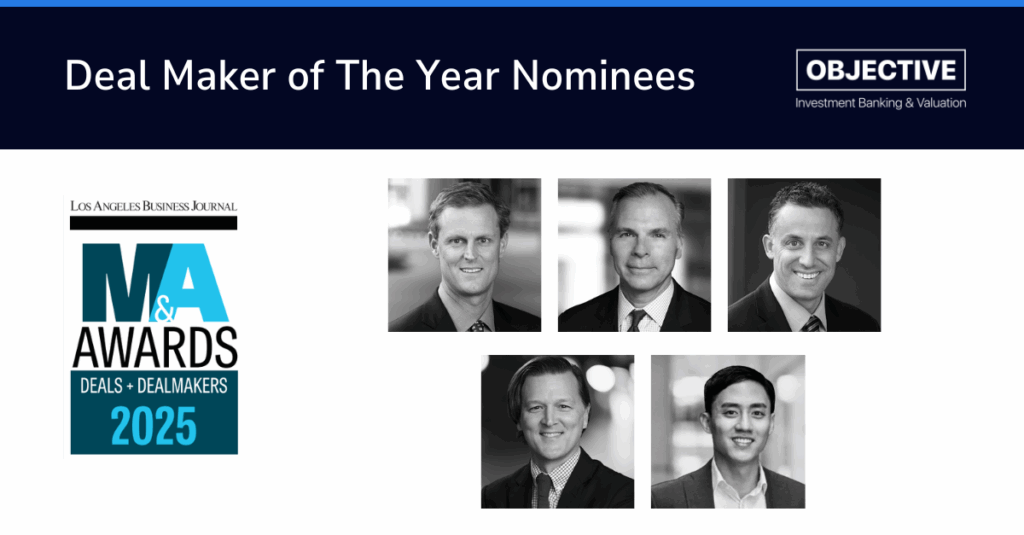Enterprise Resource Planning (ERP) SaaS platforms are deeply embedded in customers’ operations, making them highly attractive in M&A. But what separates good assets from choice assets in today’s market?
Buyers are converging on two differentiators:
- Customer retention – proof that the platform is sticky, mission-critical, and capable of expansion.
- Vertical-specific generative AI enablement – evidence that the company’s AI is tailored to the workflows and data of a particular industry, not just generic functionality.
At Objective, Investment Banking & Valuation, we help SaaS founders align with these priorities to maximize outcomes (see our Investment Banking practice).
ERP SaaS M&A Momentum: Deals Reinforcing Retention + AI
|
Target / Acquirer |
Deal Rationale & AI Angle |
Valuation / Structure Notes |
Signal Value |
|
IFS (Cloud ERP + Industrial AI) |
In April 2025, IFS raised a minority stake from Hg, ADIA, and CPP Investments while existing owners EQT / TA retained positions. The deal cited demand for “Industrial AI applications” as a growth driver. (IFS) |
Valued at €15 billion in the minority stake transaction. (IFS) |
A public software with strong AI orientation commanding a multi-billion valuation — a clear signal that ERP + AI = strategic leverage |
|
Epicor acquires Smart Software |
Epicor expanded its ERP platform by acquiring an AI-powered inventory planning / optimization solution to infuse predictive intelligence in supply chain / inventory workflows. (Epicor) |
Financial terms undisclosed publicly. (Nasdaq) |
Demonstrates that ERP incumbents are actively buying AI modules rather than building in house, validating that best-of-breed AI integration is strategic |
|
SAP acquires WalkMe (Digital Adoption / AI UX layer) |
In September 2024, SAP completed its acquisition of WalkMe to supercharge AI-driven adoption across business workflows and embed contextual intelligence in its ERP / enterprise stack. (SAP News Center) |
~US$1.5 billion in cash consideration (at ~$14 per share) (WalkMe – Digital Adoption Platform) |
Though not core ERP, this deal underscores how acquirers see value in AI adoption layers that embed into ERP workflows |
|
(Other consulting / bolt-on acquisitions ongoing in ERP ecosystems) |
Many ERP players are making smaller AI / automation bolt-on acquisitions to keep pace with buyer expectations |
Often undisclosed or modest in scale |
Reinforces that AI capability is being treated as table stake in ERP systems |
These deals help substantiate the positioning: ERP SaaS platforms that have credible AI modules, data moats, and adoption signals are no longer fringe, they’re becoming the differentiated axis on which acquirers compete.
Why AI-Enabled ERP Is Becoming a “Choice Asset”
- Buyer Selectivity & Multiples Differentiation
Major investment banks and strategic buyers now view AI capability as a key filter in deal screening. Platforms that show real usage, retention lift, and margin leverage from AI are more likely to be bid aggressively rather than field “baseline SaaS” pricing. - Reduced Execution Risk in Rollups & Technology Integration
ERP acquirers often plan to integrate or consolidate technology stacks. If a target already has AI modules and data infrastructure, acquirers see less risk in integration, versus trying to bolt AI onto an architecture post-deal. - Higher Operating Leverage & Marginal Cost Improvements
When AI reduces support, onboarding, or engineering cost per incremental customer, the margin expansion opportunity is larger—and that gets baked into valuation models. - Data & Model Moats Entrench Switch Costs
ERP systems sit at the heart of operations. When AI models are trained on domain-specific, proprietary data (e.g., maintenance logs, sensor outputs, supply chain telemetry), switching becomes not just a UI migration but a data / intelligence migration. That raises exit barriers for buyers and sellers alike. - Wider Market Narrative & Growth Optionality
ERP + AI is a narrative that aligns with macro trends: digital transformation, AI adoption, industry verticalization. Buyers want assets that can scale with narrative, not just with revenue.
Given these forces, ERP SaaS with mature AI capabilities is increasingly viewed not just as “interesting” but as choice assets in competitive M&A processes.
What Acquirers Are Looking for in ERP SaaS – Updated with Deal Insights & Non-Obvious Nuances
Below is a refined framework, now augmented with real deal relevance and deeper insight.
- Recurring Revenue with AI Expansion Optionality
Acquirers expect high subscription revenue. But what sets AI-enabled assets apart is showing that AI modules can resegment existing users with incremental ARPU.
- Use controlled experiments or pilot cohorts to demonstrate that customers exposed to AI upgrades renew better, expand more, or churn less.
- Structure AI modules as “premium tiers”—not optional fluff—with clear paths to adoption.
- Retention & Churn with Behavioral Signals
Gross retention, net retention, and cohort churn remain foundational.
- But deepen the analysis by showing lift curves comparing heavy AI users vs. non-AI users.
- Use survival / hazard modeling to quantify churn probability reduction due to AI adoption.
- Collect “anchor accounts” (flagship users) who have expanded specifically because of AI modules and use those case studies.
- Vertical Intelligence, Data Moats & Proprietary Models
Break free of horizontal ERP generality:
- Build and own vertical AI models (e.g. predictive maintenance in industrial, demand forecasting in distribution).
- Use large proprietary datasets that are expensive or impossible for entrants to replicate.
- If possible, monetize and license model outputs (e.g. benchmark intelligence) to amplify stickiness.
- Efficiency Gains & Leverage from AI
Traditional efficiency metrics still matter: CAC, LTV, payback, gross margin, Rule of 40.
- Provide before/after cost deltas showing AI’s impact on support, onboarding, or engineering.
- Quantify how much headcount growth AI can absorb.
- Show examples where AI shortened deployment cycles or reduced config complexity.
- Deep Technical & AI Diligence Readiness
Tech diligence now includes AI-specific layers:
- Data pipeline, labeling, versioning, lineage, drift monitoring.
- Model explainability, fallback logic, error containment.
- Compliance (GDPR, CCPA, model privacy), auditability, and governance.
- Document architectural diagrams, test suites, logs, performance benchmarks.
Founders who come prepared with AI diligence artifacts shorten cycles and face fewer retrades.
- Narrative: From ERP Vendor to AI-First Workflow Platform
Your pitch must evolve:
- Position your ERP not as a system of record, but as an AI copilot that orchestrates decisions across modules.
- Publish thought leadership / whitepapers showing your AI model roadmap.
- Show a credible multi-year AI roadmap where the platform evolves into intelligence orchestration, not static modules.
Frequently Asked Questions (Enhanced)
Q: Is vertical AI adoption more valuable than generic AI?
Yes. Acquirers pay premiums for ERP platforms with vertical-specific AI because it locks in customers with unique data models and workflows.
Q: What retention metrics matter most?
Net revenue retention, gross retention, and churn by cohort are top priorities. Vertical-specific retention improvements (e.g., healthcare customers renewing at 95%+) stand out.
Q: How do you share AI impact metrics without giving away IP?
Use aggregated cohort data, lift charts, anonymized deltas, and narrative case studies. Do not expose model architecture, hyperparameters, or proprietary training strategies in early pitches. Safeguard your IP while proving impact.
About The Author

Thomas Lin specializes in sell-side M&A advisory for founder-led, growth-stage SaaS and Technology businesses. With expertise in the LegalTech, GRC, Field Service Management, and PropTech sectors, Mr. Lin is skilled in guiding complex transactions for technology-driven companies. Before joining Objective, Mr. Lin spent nearly nine years at Vista Point Advisors, rising to Principal and closing 12+ transactions worth over $1.1 billion, including the $100M+ sale of FormSwift to Dropbox and the majority recapitalization of TravelNet Solutions by Blue Star Innovation Partners. Mr. Lin earned his Bachelor of Business Administration from UC Berkeley’s Haas School of Business and is a FINRA-registered securities representative.
Disclosure
This news release is for informational purposes only and does not constitute an offer, invitation or recommendation to buy, sell, subscribe for or issue any securities. While the information provided herein is believed to be accurate and reliable, Objective Capital Partners and BA Securities, LLC make no representations or warranties, expressed or implied, as to the accuracy or completeness of such information. All information contained herein is preliminary, limited and subject to completion, correction or amendment. It should not be construed as investment, legal, or tax advice and may not be reproduced or distributed to any person. Securities and investment banking services are offered through BA Securities, LLC Member FINRA, SIPC. Principals of Objective Capital are Registered Representatives of BA Securities. Objective Capital Partners and BA Securities are separate and unaffiliated entities.








